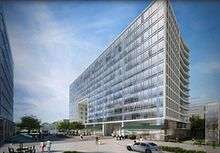Capitol Crossing
Capitol Crossing is a $1.3 billion real estate development often also referred to as a community revitalization project[1] in downtown Washington, D.C. Construction on the project began in 2014 and is expected to continue until 2021.

The Capitol Crossing project is privately funded, and is one of the largest ongoing private development in DC.[2] This 2.2 million sqft project covers a 7-acre site above I-395 and consists of 5 mixed used buildings: 200 Massachusetts, 250 Massachusetts, 200 F Street, 600 Second, and 201 F Street.[3] These five multi-use buildings will span three long blocks over the highway.[4] The project is expected to have 75,000 square feet of retail, restaurants, and cafes, and below the project will be a 4-level garage with 1,146 parking spaces and 440 bicycle parking spaces.[5] As a major infrastructure project, Capitol Crossing is expected to bring 8000 permanent jobs as well as contribute over 40-million-dollar tax per year once established.[4]

Developers of Capitol Crossing have claimed the project will create a greener, more sustainable city with Washington D.C.’s first “eco-district.”[1] The five buildings are expected to be LEED The three blocks being built do not take land from Virginia or Maryland, but bring back land that was taken years ago.[6] Platinum certified and the finished site will feature cogeneration power, rainwater catchment, and eco-chimney filtration.[7]
The neighborhoods of Capitol Hill and the East End, which have been long divided by the highway, will be reconnected in the near future due to the construction of a platform adjacent to Massachusetts Avenue.[8] According to city officials, this $200 million platform built over the highway will enhance the vibrancy of east downtown community of Washington, D.C.[9]

According to Office of the Deputy Mayor for Planning and Economic Development, the development project will provide 150 residential units, and over one third of them are affordable to most of the median income.[1]
References
- 1 2 3 Goldchain, Michelle. "Capitol Crossing: What to Expect from One of D.C.'s Largest Revitalization Projects", "DCGovernment", 6 April 2016.
- ↑ Banister, Jon. "$1.3B CAPITOL CROSSING PROJECT BEGINS TO GO VERTICAL", "Bisnow", 15 June 2016.
- ↑ Capitol Crossing Washington D.C.
- 1 2 Sherwood, Tom. "$1.3 Billion Capitol Crossing Project Will Be One of D.C.'s Biggest Projects Ever -- But Drivers, Beware", "NBC", 13 June 2015.
- ↑ Sadon, Rachel. "Five Things To Know About The Capitol Crossing Project, DCist", "Gothamist", 12 May 2015.
- ↑ Ackland, Matt. "$1.3 billion Capitol Crossing construction project breaks ground in DC", "FOX5", 12 May 2015.
- ↑ Capitol Crossing: Sustainability Features
- ↑ Fox, Kohn. "Capitol Crossing DC", "Architect", 12 May 2015.
- ↑ Lazo, Luz. "Major work for Capitol Crossing project is set to begin on I-395", "The Washington Post", 23 June 2015.